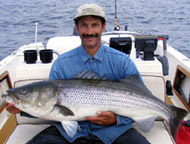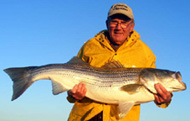 |
|||
|
Striper Fishing Plugs and Soft PlasticsTips and tricks that you can use to improve your Striper fishing skills in Rhode Island.By Chris Bell.Striper Plugs and Soft Plastics. There is nothing quite like seeing a bass smash a topwater plug on the surface. The splash, the tail in the air as they roll on it, then the run as you line comes tight, its always exciting. Topwater plugs work mostly under low light conditions like dawn and foggy days. When fish are feeding on the surface they will also produce. I use some standard manufactured plugs but my best one for charters is an Anco plug that I build myself. It is a floating topwater type plug with a unique action and is very easy for the average angler to use with a only a little coaching. This is important, as I do a lot of charters and the easier it is to teach the clients the more time we can all spend doing what we are out there for: fishing. You can also use poppers and walker plugs but especially the walkers require a fairly high level of skill to retrieve properly to entice the fish into a strike, so these are definitely much less useful. As an experienced fisherman, I can catch them pretty easily with these types of plugs, but it is not so easy to pass that skill onto others in a half day fishing trip, especially if their casting skills are in need of improvement. Rule of thumb, real fisherman donít like beautiful blue-sky days, overcast and fog is better for fishing. Once the sun is up it becomes time to switch to the soft plastics. Bass have large eyes that are optimized to see at night and in low light conditions. They tend to stay down once the sun is up and head to deeper water as it reaches its zenith. Soft plastics can be used to get down there to where the fish are. I see a lot of anglers use soft plastics and it seems that the majority of them cast it out, and almost immediately after it hits the water they close the bail and start their retrieve. This just doesnít work unless the fish are on the surface. You need to work the entire water column to find them. If they are holding near the bottom in a moderate drift and 20 feet of water, count to 10 before you close up and start your retrieve. |
|
|
|
|
This allows the soft plastic to get near the bottom before moving it. The rule of thumb is half the depth in your count before retrieving. Also, vary the speed of your retrieve, mix it up, jig it, just retrieve slowly, until you find what works for that day and spot. If itís a strong current you might not retrieve it at all. Just remember, if its not working, your retrieve is wrong or your not getting down to the fish. It isnít because the soft plastic is no good. If you get hit and donít hook the fish, immediately work your soft plastic like its wounded, with slow reeling and short jigs, it makes them more likely to hit it again. Iíve had 6 or 7 hits in a row before hooking up using this trick. The tendency of most anglers is to haul back and reel fast, but this just pulls the lure away from the fish, which might work with bluefish but not necessarily with bass. I use a variety of soft plastics, storms, sluggos, Fin-S, curly tail grubs, etc. They are always used with a jig head or bucktail. The jig head weight should be between 3/8 ounce to 1.5 ounces depending on the depth and current. Use ones that match the hatch of what may be out there, e.g. sluggos in green/white for sand eels, 6Ē pearl storms for menhaden, etc. Matching the hatch can sometimes be very critical. I fished Block Island several days in June of 2007 using topwater plugs with no success (which is very unusual) and it was because the bass were feeding on hordes of 3Ē sand eels, you would see them swirl the surface but they never needed to jump because these small sand eels didnít have a prayer of outrunning them. The fish were just slurping them up. Acres of fish, swirls all around the boat for hours and they wouldnít touch even the smallest topwater plug. Only soft plastics worked very slowly right near them would entice a strike. Well, none of these techniques are any good unless you know where and when to find some fish. Using these tactics on a smooth, sandy bottom isnít going to prove much. You need to find structure that holds fish or schools of fish feeding at the surface. Underwater rocks and other structure with currents the run past them are prime spots for bass. Bass can be aggressive feeders in the early morning, but after that they mostly prefer to ambush their prey, which uses fewer calories (well you could say they are either lazy or smart). They would hold on the downcurrent side of the structure, waiting for something to tumble over the top. Keep a lookout for birds, bait, and splashes in the water. I see so many anglers go cruising past as I am casting to feeding fish, they are aware of their surroundings, instead being focused on getting to where they are planning on going. Some of the best fishing Iíve ever experienced was due to paying attention and spotting the activity that indicated feeding fish.
Catch Ďem up! Go to Chris's Adventure rhode island Light Tackle fishing charters website. |
||
|
copyright 2010 Striper Fishing Charter Boats in Rhode Island |
|||


